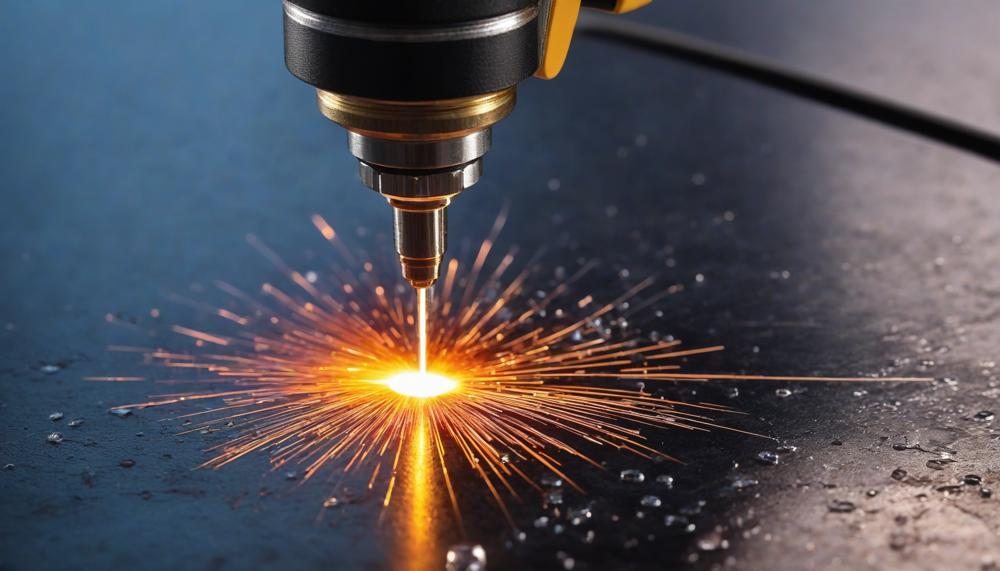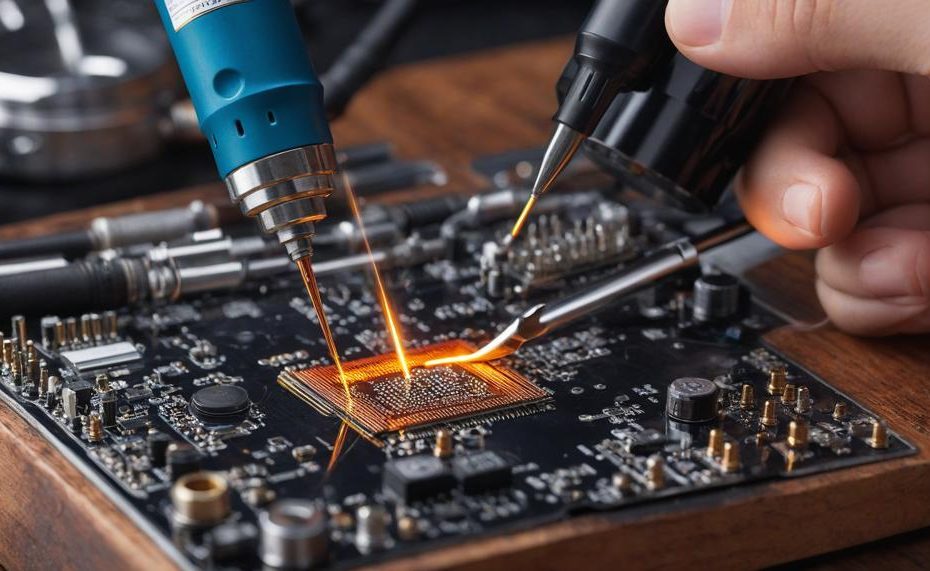In the intricate dance of soldering, where precision melds with artistry, mastering the control of your soldering iron’s temperature becomes the linchpin for achieving flawless connections. Welcome to the enlightening journey towards optimizing your soldering endeavors by mastering the art of temperature regulation.
Whether you’re a hobbyist tinkering in your garage or a professional crafting delicate circuitry, understanding and measuring your soldering iron’s temperature is not just beneficial—it’s essential.
In this blog post, we will unravel the mystique surrounding soldering iron temperatures, guiding you through the practical wisdom and techniques that ensure your tool is not just a piece of metal, but a finely tuned instrument of precision.
Key insights you’ll gain include:
- The Why: Uncover the critical reasons behind maintaining the optimal temperature for different soldering projects, ensuring both the longevity of your tools and the integrity of your connections.
- The How: Dive into a variety of methods for measuring your soldering iron’s temperature, from traditional techniques to modern, tech-savvy approaches.
- The What Next: Learn how to interpret temperature readings and adjust your soldering practices for enhanced precision and reliability.
- The Tips: Discover practical tips for maintaining your soldering iron at its peak performance, ensuring it delivers the right heat for every solder joint you make.
Prepare to elevate your soldering skills to new heights, ensuring every joint is a testament to your expertise and every project a showcase of precision. Let’s embark on this journey together, transforming the ordinary into the extraordinary, one solder joint at a time.
Contents
- 1 Why Is Temperature Control Important for Soldering?
- 2 Using a Thermometer to Check the Temperature of a Soldering Iron
- 3 Using Thermal Paste/Compound to Check the Temperature of a Soldering Iron
- 4 Checking Temperature with Built-in Systems on Some Soldering Irons
- 5 Choosing an Accurate, Reliable and Easy-to-Use Method for Checking Temperature
- 6 Conclusion
Why Is Temperature Control Important for Soldering?
Temperature control in soldering is akin to the throttle in a car; it determines the speed and efficiency at which you reach your destination, or in this case, the quality and durability of your solder joints.
This facet of soldering is not just about cranking up the heat but understanding and applying the precise amount of temperature needed for different materials and projects.
Quality of Solder Joints
Temperature control is the backbone of producing high-quality solder joints. Too hot, and you risk damaging the components or the board; too cool, and the solder won’t properly melt or bond, leading to weak joints.
| Desired Outcome | Impact of Proper Temperature Control | Consequence of Poor Temperature Control |
| Strong Bond | Creates a smooth, uniform solder that properly adheres to the surfaces. | Leads to brittle or cold joints with poor electrical connectivity. |
| Component Integrity | Prevents thermal damage to sensitive components and PCB tracks. | Can cause component failure or board delamination. |
| Aesthetic Finish | Ensures a clean, professional finish without excess flux or solder blobs. | Results in messy joints that might require rework, adding time and cost. |
Consistency and Efficiency
In the world of soldering, consistency is king. Achieving uniform results across numerous joints ensures not only the reliability of the work but also the efficiency of the process.
Proper temperature control helps maintain a steady workflow, reducing the need for touch-ups or repairs, which in turn, saves time and material.
Safety and Longevity
The right temperature settings extend the life of your soldering iron tips and ensure a safer working environment. High temperatures can lead to faster oxidation and wear of the tips, while correct temperature use minimizes these effects and preserves the equipment’s effectiveness over time.
Tips for Optimal Temperature Control:
- Adjustable Temperature Settings: Utilise a soldering iron with variable temperature controls to suit different soldering tasks.
- Preheating the Work Surface: Ensures a quicker and more even solder melt.
- Appropriate Tip Size and Shape: Matches the heat transfer to the job at hand, avoiding under or overheating.
- Regular Maintenance: Cleaning and tinning the tip keeps it in optimal condition, ensuring better temperature accuracy.
Common Pitfalls to Avoid:
- Incorrect Temperature Setting: Too high or too low can both ruin your work.
- Wrong Tip Selection: Impacts heat transfer efficiency.
- Neglecting Tip Care: Leads to poor heat transfer and potential damage.
Understanding and controlling the temperature in soldering is crucial. It’s the difference between a job well done and one that falls apart under scrutiny.
Using a Thermometer to Check the Temperature of a Soldering Iron

To ascertain the temperature of your soldering iron with precision and dependability, employing a digital thermometer equipped with a K-type thermocouple stands out as the method of choice.
This technique ensures that you can achieve sterling, robust solder joints, whilst also safeguarding both your safety and the longevity of your equipment. Here’s a distilled guide on why and how this method is superior:
| Method | Accuracy | Why It’s Preferred |
| Digital Thermometer with K-Type Thermocouple | High | It delivers precise temperature readings swiftly, making it indispensable for verifying the heat of soldering irons to ensure optimal soldering conditions. |
| Infrared Thermometer | Medium | While convenient for non-contact measurements, it’s less accurate due to potential interference from surrounding temperatures and emissivity of the soldering iron’s surface. |
| Traditional Liquid Thermometer | Low | It’s not suitable for soldering tasks due to the inability to withstand high temperatures and provide quick, accurate readings. |
The digital thermometer with a K-type thermocouple emerges as the most accurate and reliable method because it offers swift, precise measurements that are crucial for maintaining the appropriate temperature for soldering.
This method allows for the direct and effective monitoring of the soldering iron’s temperature, facilitating adjustments as needed to ensure the solder melts properly without damaging the components or the board.
Using Thermal Paste/Compound to Check the Temperature of a Soldering Iron
Thermal paste, also known as thermal compound or heat sink compound, is a substance designed to enhance heat transfer between surfaces. When applied to a soldering iron, thermal paste fills in any microscopic gaps between the iron’s tip and the surface being soldered, ensuring better thermal contact and more efficient heat transfer.
This is crucial for maintaining the optimal temperature of the soldering iron, which in turn affects the quality and strength of the solder joints.
Application in Soldering:
In the context of soldering, using thermal paste can help in checking the temperature of a soldering iron in a few ways:
- Improved Heat Conduction: By filling in air gaps, thermal paste ensures that heat is more evenly distributed across the tip of the soldering iron. This can help in obtaining a more accurate temperature reading when using a thermometer.
- Temperature Stability: With better heat transfer, the temperature of the soldering iron remains more stable, reducing the chances of overheating or cooling, which could otherwise affect the temperature readings.
- Protection: Thermal paste can also act as a protective layer for the soldering iron tip, preventing oxidation and wear, which can impact temperature accuracy over time.
Best Practices:
When using thermal paste with a soldering iron, it’s important to apply it sparingly and evenly to avoid any excess that could interfere with the soldering process.
It’s also advisable to clean the tip of the iron before application to ensure optimal performance.
Checking Temperature with Built-in Systems on Some Soldering Irons
Checking temperature accurately in soldering irons with built-in systems is a game changer in the realm of welding. These advanced systems ensure that heat is applied consistently and accurately, which is critical for crafting strong, reliable solder joints while safeguarding sensitive electronic components from heat damage.
Essential Attributes of Built-in Temperature Control Systems:
- Consistency: They maintain a steady temperature, vital for uniform solder application.
- Precision: Adjustments can be made to cater to various solder types and requirements.
- Real-Time Monitoring: LED displays or in-built thermometers show current temperature, aiding in precise heat application.
- Safety: Prevents overheating, protecting both the workpiece and the tool.
The Significance of Temperature Consistency:
Uniform temperature is the backbone of dependable soldering. It ensures even melting and solidification of solder, which is crucial for creating robust electrical connections.
Consistent heat prevents the formation of cold joints – a common flaw that can lead to faulty circuits.
Adapting to Different Solder Types:
Different solder materials melt at various temperatures. The built-in systems in modern soldering irons automatically adjust to these variations, providing the optimal temperature for each specific solder type.
This adaptability is crucial for achieving the best results without compromising the integrity of the components being soldered.
Monitoring and Adjustment:
While built-in thermometers and LED indicators provide a quick glance at the current temperature, for tasks demanding utmost precision, using an external thermometer or probe can add an extra layer of accuracy.
This dual-check system ensures the iron’s temperature is spot-on.
Choosing the Right Tool:
Selecting a soldering iron with an efficient built-in temperature control system hinges on individual preferences, budget constraints, and the level of precision required for the task. The blend of user-friendliness, accuracy, and reliability defines the ideal tool for any soldering job.
Here’s a brief comparison of different temperature monitoring and control features found in soldering irons:
| Feature | Advantage | Consideration |
| LED Display | Visual temperature monitoring | May not be as precise as a thermometer |
| Adjustable Control | Precise temperature setting | Requires user knowledge for optimal settings |
| Built-in Thermometer | Direct temperature reading | External validation may still be needed |
In sum, the heart of successful soldering lies in the precision and consistency of temperature control.
Choosing an Accurate, Reliable and Easy-to-Use Method for Checking Temperature
When selecting a method to gauge the warmth of your soldering iron, it’s not just about picking a tool; it’s about ensuring your soldering projects are top-notch, avoiding any mishaps with too much heat or the frustration of solder that just won’t melt. Here’s a straightforward guide to make this choice easier, keeping your soldering spot on.
Key Considerations:
- Precision and Reliability: Your tool should give you the nitty-gritty details accurately every single time. No guesswork.
- Ease of Use: You want something that doesn’t require you to be a rocket scientist to operate.
- Cost: It’s got to give you bang for your buck, providing the best accuracy for your investment.
- Adaptability: The right gadget adjusts to different types of solder, matching their melting points.
- Consistency: It’s all about getting that perfect joint every time, with even heat distribution.
| Tool | Pros | Cons |
| K-type Thermocouple Thermometer | Spot-on accuracy, great for precision work | May be pricier, requires a bit of know-how |
| Infrared Thermometer | Quick, easy scans without contact | Accuracy can be hit or miss |
| Temperature Indicator Strip | Wallet-friendly, straightforward to use | Not the best for detail-oriented tasks |
Remember, it’s not just about the tool but how you use it. A pricier thermometer won’t do you any good if it’s not suited to your soldering style or the specific needs of your project.
Likewise, even the simplest indicator strip can be a game-changer if it meets your accuracy needs. It’s all about finding the balance that works for you, ensuring your soldering is nothing short of brilliant.
Conclusion
In the realm of soldering, the temperature of your soldering iron isn’t just a number—it’s the heartbeat of your craft, ensuring every connection is a symphony of precision and durability.
Mastering temperature control is akin to conducting an orchestra, where every note must harmonize perfectly for a flawless performance. Whether using a digital thermometer with a K-type thermocouple for pinpoint accuracy or relying on the convenience of built-in systems in modern irons, understanding and adjusting your tool’s heat is pivotal.
Embrace techniques like using thermal paste for improved heat conduction or selecting the right temperature monitoring tool, ensuring your soldering iron sings in perfect harmony with your materials and tasks. Remember, the secret to soldering success lies not just in the heat applied but in the nuanced control and understanding of that heat.
By finessing your temperature control skills, you transform soldering from a mere task into an art form, where every joint is a testament to your expertise and every project a masterpiece of electrical connectivity.





